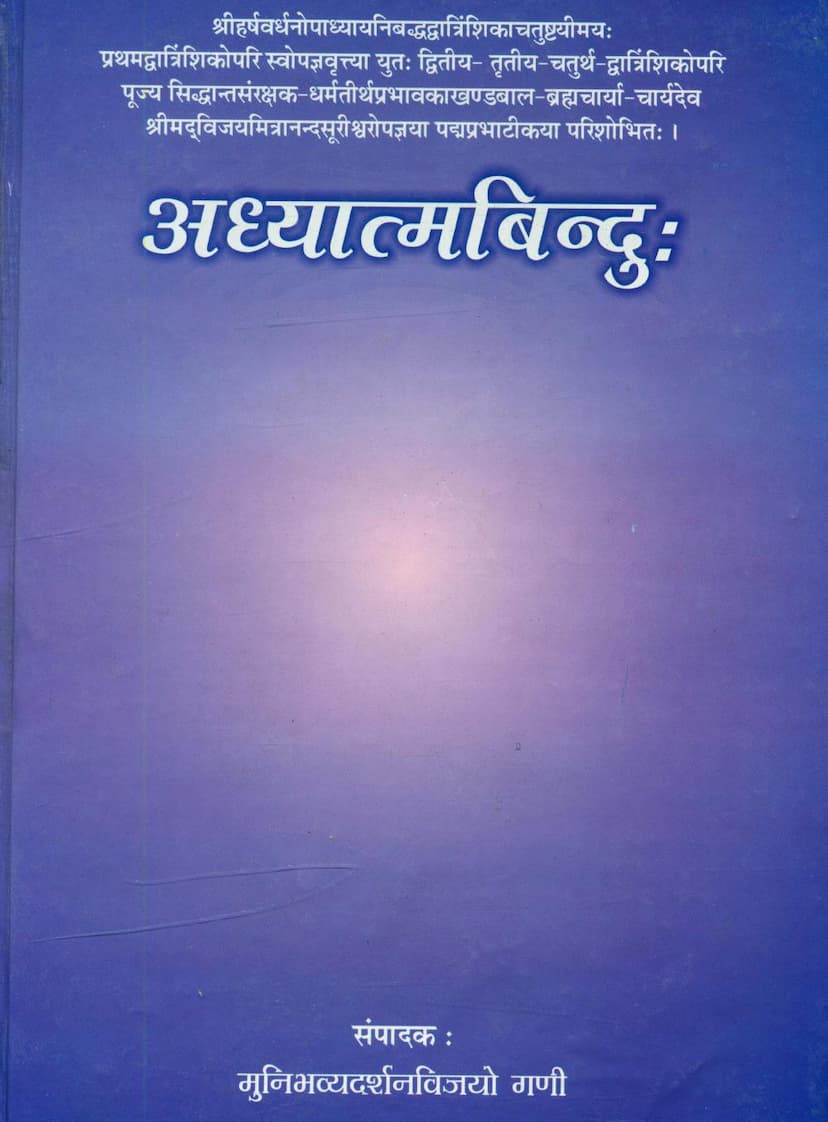Adhyatmabindu
Added to library: September 1, 2025

Summary
This is a comprehensive summary of the Jain text "Adhyatmabindu" by Muni Bhavyadarshanvijay, based on the provided pages.
Book Title: Adhyatmabindu Author: Muni Bhavyadarshanvijay Publisher: Padmvijay Ganivar Jain Granthmala Trust Catalog Link: https://jainqq.org/explore/022281/1
Overall Summary:
"Adhyatmabindu" is a significant Jain text that delves into the profound principles of spirituality and self-realization, drawing heavily from the teachings of Jain philosophy. The text is structured into four "Dwatrinsikas" (groups of thirty-two verses each). The first Dwatrinsika is attributed to Shri Harshavardhana Upadhyay and is accompanied by his own commentary. The subsequent three Dwatrinsikas are further elaborated with a commentary called "Padmprabha Teeka" by the revered Acharya Shri Vijaymitranand Surishwarji.
The core theme of "Adhyatmabindu" revolves around understanding the true nature of the self (Atman) and differentiating it from the non-self (body, senses, external objects, and even subtle karmic influences). It emphasizes the importance of Nischaya Naya (the ultimate truth or absolute perspective) and Vyavahara Naya (the conventional or practical truth). The text meticulously explains that true liberation (Moksha) is attained by focusing on the pure, unchanging, and conscious nature of the self, which is distinct from all perishable and external phenomena.
Key Concepts and Themes:
- The Nature of the Self (Atman): The text expounds on the Atman as pure consciousness, blissful, eternal, and uncreated. It is characterized by infinite knowledge, perception, bliss, and energy. It is separate from the body, senses, mind, and all karmic matter.
- Distinction between Nischaya and Vyavahara Naya:
- Nischaya Naya (Ultimate Truth): This perspective focuses on the absolute reality, the inherent nature of the soul, which is pure, formless, and unchanging. It emphasizes the non-dualistic nature of the self.
- Vyavahara Naya (Conventional Truth): This perspective deals with the practical realities of the world, including the soul's interaction with karma, the body, senses, and the resulting experiences of pleasure and pain. It serves as a means to approach the ultimate truth.
- The Illusion of Causation and Action: The text clarifies that while the soul appears to perform actions and experience results due to its association with karma, in its essential nature, it is actionless. The apparent actions and experiences are attributed to the interaction of karmic matter and the soul's deluded state.
- The Power of Knowledge and Discrimination: The text highlights the transformative power of right knowledge (Samyak Jnana) and right conduct (Samyak Charitra). Through the practice of discrimination (Bheda Jnana), one can discern the self from the non-self, thereby dismantling the root causes of bondage.
- Karma and Liberation: "Adhyatmabindu" details how karmic matter, through its various modes, binds the soul and causes it to transmigrate through different life forms. Liberation is achieved by eradicating karmic residues through spiritual practices, right knowledge, and detachment.
- Spiritual Practices: The text implicitly and explicitly encourages practices such as contemplation, meditation, self-inquiry, and adherence to ethical principles as means to realize the self and overcome karmic bondage.
- Critique of Superficial Practices: It often contrasts genuine spiritual understanding with superficial rituals or practices performed without the correct inner disposition or knowledge, emphasizing that mere external actions are insufficient for liberation.
Structure of the Text (as indicated by the provided pages):
- Page 1-2: Title page, publisher details, and dedications to various spiritual preceptors. It highlights the commentary by Acharya Vijaymitranand Surishwarji on the second, third, and fourth Dwatrinsikas.
- Page 3-4: Publication details, price, and acknowledgments for support.
- Page 5: Extensive salutations and expressions of gratitude to numerous revered spiritual masters, including Shri Vijay Premsurishwarji, Shri Vijay Ramachandra Surishwarji, Shri Vijay Bhuvanbhanu Surishwarji, and Shri Padmvijay Ganivar. This section reflects the tradition of acknowledging spiritual lineage and guidance.
- Page 6-7: The "Prakathan" (Preface) by Acharya Shri V. Mitranand Suri. This section details the historical context of the text's discovery, the process of its editing and commentary, and the efforts involved in its publication. It mentions the discovery of valuable manuscripts, including a commentary on the first Dwatrinsika by Shri Harshavardhana Upadhyay and the original text of "Adhyatmabindu" itself. It also notes the contribution of Muni Shri Bhavyadarshan Vijay in preparing the manuscript.
- Page 8 onwards: The text of the "Adhyatmabindu" begins, starting with the first Dwatrinsika and its commentary. The commentary meticulously explains each verse, providing etymological derivations, philosophical interpretations, and cross-references to other Jain scriptures.
- First Dwatrinsika: Focuses on Nischaya-Vyavahara principles.
- Second Dwatrinsika: Deals with the nature of the agent (Karta) and the object (Karma).
- Third Dwatrinsika: Emphasizes the contemplation and realization of the self's true nature (Atma Swarupa Bhavana).
- Fourth Dwatrinsika: Illuminates the pure nature of the self (Shuddha Swarupa Prakarshika).
- Page 40-42: The text continues with the second Dwatrinsika and its commentary ("Padmprabha Teeka").
- Page 43 onwards: The commentary continues for the subsequent Dwatrinsikas.
- Page 103-104: An index of the verses, linking them to their respective Dwatrinsikas.
Significance:
"Adhyatmabindu" serves as a guide for spiritual aspirants seeking to understand and embody the Jain path to liberation. By elucidating complex philosophical concepts in a structured manner, and through the extensive commentaries provided, it aims to facilitate a deep and abiding realization of the soul's inherent purity and potential for ultimate freedom. The text emphasizes that true spirituality lies not in external observances alone but in the profound inner transformation brought about by self-knowledge.